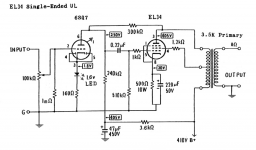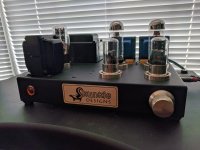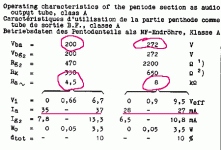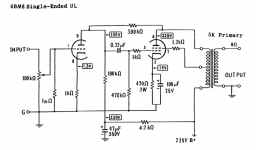Thanks. I've been buying those for all my builds as it becomes the "nut" for the screws that hold the tube sockets to the chassis. I've been getting those + volume knobs from these folks.
Tube Shield Ring Washer
Neato!!
Do not get discouraged.
This thread should be able to help you build an amplifier that will be satisfying.
But beware, you may get addicted to building another amplifier after that.
I'm not discouraged.
This will be the third amp I've built from scratch and the second I designed the schematic for. I've worked with electronics for 35 years so I kinda understand what's going on here. The previous one was a 6SQ7 driving an EL34 and it sounds fantastic. And no, you aren't going to find a schematic online for using a 6SQ7 in a HiFi amp, even though it's a very linear tube with a high amplification factor, higher than the triode in this 6BM8.
Honestly, I was just wanting to share the process of this build in a video series with folks, hopefully to show a beginner or someone who has never attempted this, it's not rocket science. Yet some people seem to want to "blow out my candle" before I even have a chance to hit the power button. Or maybe create this illusion that mere mortals should not attempt things like this?
Possibly when I am done it doesn't work at all, or sounds like crap and I have to work through that. But honestly this isn't really that wild a schematic, it's very close in the main parameters (Plate voltage, output transformer Z etc) to a retail kit that's sold, so I'll be shocked if it doesn't at least work decently. In fact it's very close to the general design I used on my 6SQ7/EL34 amp. I stayed away from global NFB, as those designs are very dependent on the transformer used and more prone to oscillation/stability issues. I also am not running it in pure pentode mode for the same reasons.
I also know once I get it on a scope, I can start fine tuning it where it's happy. If anyone had actually watched the video, I explain how things like the Schade feedback values will likely need to be tuned to this specific amp, values changed to dial in voltages, possibly trying different triode cathode bias designs and listening to how they change the sound etc. You know, experimenting since this is a new design to me.
That's the whole reason for making a video series, to document the process, and possible failure points a long the way, and how to address those.
Anyway, here is the schematic for my previous build that sounds unbelievably good to me. Then again, I'm sure there will be someone here who will want to explain how this one can't work either.
Attachments
The original complaint against your design is based on opinion. There is nothing about the 6BM8 that makes it unstable or a bad choice for beginners.
Early on, engineers could not explain how the bumblebee could fly.
The bumblebee just ignored popular opinion.
The bumblebee just ignored popular opinion.
With regards to 5K vs 7K transformer, I would like to point out that a 7K transformer would be correct for a Pentode amplifier, and this value is called out in the Svetlana datasheet.
However, this is not a Pentode amplifier, it is a UL amplifier using a Pentode tube. With the typical 43% UL tap a 5K transformer isn't far off from ideal.
The Tung-sol 6BM8 tube datasheet included audio amplifier data.
Cary on stephe.
However, this is not a Pentode amplifier, it is a UL amplifier using a Pentode tube. With the typical 43% UL tap a 5K transformer isn't far off from ideal.
The Tung-sol 6BM8 tube datasheet included audio amplifier data.
Cary on stephe.
The 6BM8 pentode's dissipation rating is 7 watts. As a common rule of thumb, the load impedance's optimum is plate voltage ^2/plate dissipation, hence 240²/7 = 8.2 kohms.
Kay Pirinha,
A quick question. Hopefully the OP will indulge us.
Rules of thumb can be useful, but they are typically broad approximations. I have not seen this one before and I’m imtrigued. Could you tell more about it and its applicability to different classes of amplification and PP, SE and UL operation?
I checked these examples and found it off somewhat, if I applied it correctly:
1. 300b SE
WE specified 7 watts output at 350V anode, -78V bias with transformer load (Za-a) of 4k
Your rule suggests Za-a of 2.1k
2. Dynaco ST70 EL34 PP, UL with Za-a=4.3k
Your rule suggests 5.7k
3. Williamson KT66, Triode, PP 450V anode, -38V bias, with Za-a=10k (as originally specified).
Your rule suggests 6.8k
Last edited:
None of us should feel offended by comments on DIYaudio. One of beautiful things about this forum is the comradeship of folks working together but separately towards a nebulous goal. If I make an error, I would certainly hope and expect others to correct that error. If someone sees a better engineered approach, we all need to learn from it.
In the OP's case, an excellent, elegant design, well suited to either a first builder or someone wanting its compactness, etc. is presented. Other folks offer variations to include valves most likely to be available in the future, or with a larger margin of dissipation, etc. This is not a critical attack - it's just the expected (and hoped for!) response in a technical forum.
All good fortune,
Chris
In the OP's case, an excellent, elegant design, well suited to either a first builder or someone wanting its compactness, etc. is presented. Other folks offer variations to include valves most likely to be available in the future, or with a larger margin of dissipation, etc. This is not a critical attack - it's just the expected (and hoped for!) response in a technical forum.
All good fortune,
Chris
TheGimp,
PRR,
Yes, I agree.
A pentode might have a plate resistance, rp, of 15k
The same pentode tube in UL might have a plate impedance, rp, of 3.5k
The same pentode tube in Triode wired mode might have a plate impedance, rp, of 1700 Ohms.
How well that pentode tube in the above various modes drives a 5k primary impedance can vary according to whether negative feedback is applied, or not.
And the same goes for Beam Power tubes, in beam power mode, UL mode, and Triode wired mode.
Each of these modes, and negative feedback or not, has tradeoffs of power, efficiency, distortion, damping factor, frequency response, simplicity of design, etc.
And then there are the operating point of current, p-k voltage, bias voltage, and primary impedance, etc., which give other differences and tradeoffs.
PRR,
Yes, I agree.
A pentode might have a plate resistance, rp, of 15k
The same pentode tube in UL might have a plate impedance, rp, of 3.5k
The same pentode tube in Triode wired mode might have a plate impedance, rp, of 1700 Ohms.
How well that pentode tube in the above various modes drives a 5k primary impedance can vary according to whether negative feedback is applied, or not.
And the same goes for Beam Power tubes, in beam power mode, UL mode, and Triode wired mode.
Each of these modes, and negative feedback or not, has tradeoffs of power, efficiency, distortion, damping factor, frequency response, simplicity of design, etc.
And then there are the operating point of current, p-k voltage, bias voltage, and primary impedance, etc., which give other differences and tradeoffs.
Last edited:
I'm really starting to feel like maybe I shouldn't be posting to this forum, I didn't realize there was this level of hostility here. 🙁
IMO it only feels like hostility, but it is actually that you have tapped in to a pool of knowledgeable people and they are sharing their thoughts on what you (or in my case, I) have presented on the forum. It feels a bit intimidating at first but it is actually very valuable. 🙂
Then every 6BM8 schematic I have seen online is wrong. Everyone I have seen is showing using them with a 5K OT.
I'm really starting to feel like maybe I shouldn't be posting to this forum, I didn't realize there was this level of hostility here. 🙁
Classique – 6BM8/ECL82 SE – 3W – White Paper – Caledonian Audio
Needing OT for SE ECL82/6BM8 amplfier
6BM8 Valve Audio Amplifier
Well, these examples either don't specify the plate voltage, or, if specified, run the 6BM8 pentode well beyond it's plate dissipation ratings (10 watts or 9.2 watts instead of 7). I'd really not recommend this.
Kay Pirinha,
A quick question. Hopefully the OP will indulge us.
Rules of thumb can be useful, but they are typically broad approximations. I have not seen this one before and I’m imtrigued. Could you tell more about it and its applicability to different classes of amplification and PP, SE and UL operation?
I checked these examples and found it off somewhat, if I applied it correctly:
1. 300b SE
WE specified 7 watts output at 350V anode, -78V bias with transformer load (Za-a) of 4k
Your rule suggests Za-a of 2.1k
2. Dynaco ST70 EL34 PP, UL with Za-a=4.3k
Your rule suggests 5.7k
3. Williamson KT66, Triode, PP 450V anode, -38V bias, with Za-a=10k (as originally specified).
Your rule suggests 6.8k
I recommend to not compare apples with oranges. We're talking about SE pentode mode here, not triode nor PP!
Best regards!
Well, these examples either don't specify the plate voltage, or, if specified, run the 6BM8 pentode well beyond it's plate dissipation ratings (10 watts or 9.2 watts instead of 7). I'd really not recommend this.
"The pentode section has a load of 5K ohm in the form output transformer. Using a supply of 250V and cathode resistor of 560 ohm the system is outputting around 3 watts per channel."
Classique – 6BM8/ECL82 SE – 3W – White Paper – Caledonian Audio
"The circuit shown here is for use from a B+ of 230V at around 40mA and with a 5K to 8R speaker transformer."
6BM8 Valve Audio Amplifier
I'm curious what the point of being so negative to the point of making up things to attack my project/ideas? Do you have a problem with smart women or?
Don't worry, I will never post anything to this forum again, I get enough of this from men at work.
I'm curious what the point of being so negative to the point of making up things to attack my project/ideas? Do you have a problem with smart women or?
Don't worry, I will never post anything to this forum again, I get enough of this from men at work.
Oh no... As a 65 year old "newbie", heading into this as a retirement hobby, please reconsider. My first few posts here didnt even pass the giggle test (as well as some recent ones), but the forum is a great resource. There are some great minds here, some come with an ego and various levels of patience and tact (IOW humans). Anyway I subscribed to your youtube and found the schematic walkthrough to be very cool, I even checked my boxes for a 6BM8.
Stephe,
I didn't even know you're a woman. Where from should I? And why do you feel that offended?
Both examples you mentioned in your last posting are exactly the ones that grossly exceed the pentode's plate dissipation rating at 10 and 9.2 watts, respectively. I'd really not recommend that in SE and other class A designs.
A plate load impedance of about 5 kohms fits well for 6AQ5's and 6BQ5's, running in SE at 250 V plate voltage and 48 mA plate current, hence a plate dissipation of 12 watts.
Best regards!
I didn't even know you're a woman. Where from should I? And why do you feel that offended?
Both examples you mentioned in your last posting are exactly the ones that grossly exceed the pentode's plate dissipation rating at 10 and 9.2 watts, respectively. I'd really not recommend that in SE and other class A designs.
A plate load impedance of about 5 kohms fits well for 6AQ5's and 6BQ5's, running in SE at 250 V plate voltage and 48 mA plate current, hence a plate dissipation of 12 watts.
Best regards!
Hate to say it... But there's much more hostility on other electronics forums towards tube builds. Joined this forum after being repeatedly harassed and demeaned on another forum
for wanting to build a tube amplifier as fun project during the pandemic shut down last year.
Joined this forum and never went back to the other one. The mods here are pretty good at keeping things 'civil', imo.
Jim
for wanting to build a tube amplifier as fun project during the pandemic shut down last year.
Joined this forum and never went back to the other one. The mods here are pretty good at keeping things 'civil', imo.
Jim
I agree Jim. I used to be a moderator on here. I learnt a lot from the the group of mods. They do a great job of making this a fine forum.
Addendum: I really didn't intend to disregard your little amp suggestion, Stephe. Sorry for the impression I may have aroused. The warning of possible oscillations bases in German literature (Kurt Ratheiser, Heinrich Barkhausen, just to name some) where the authors adviced to take extremely care with triode/power pentode combo valves. If designed and executed properly, these tubes will work satisfyingly. They're intended to do so, at the end 😉.
Anyway I dare to insist that plate load of 5 kohms isn't proper if the 6BM8 7 watts pentode is running at a plate voltage of about 250 V.
Best regards!
Anyway I dare to insist that plate load of 5 kohms isn't proper if the 6BM8 7 watts pentode is running at a plate voltage of about 250 V.
Best regards!
Last edited:
I've got this amp running and it sounds good. I simplified the triode cathode arrangement to an unbypassed resistor, but plan to play with other options, as well as the Schade feedback value by ear. It looks good on the scope, a nice clean square wave and doesn't show clipping until right at full volume.
I did realize the schematic I drew up had the pins numbered wrong! The B+ came out a little lower than I thought it might be, but at ~200V across the output section, it should be fine. I also cooled off the bias a bit to respect the transformer rating and not stress the tubes, this isn't being built as a powerhouse. The output section should be at aprox 80% now.
I did realize the schematic I drew up had the pins numbered wrong! The B+ came out a little lower than I thought it might be, but at ~200V across the output section, it should be fine. I also cooled off the bias a bit to respect the transformer rating and not stress the tubes, this isn't being built as a powerhouse. The output section should be at aprox 80% now.
Attachments
Francois G: Kay could have been more explicit: the rule of thumb is for SE pentode mode, and doubled for class A P-P. Class AB will be lower. Triodes can be used over a wider impedance range; 3 times the plate resistance is frequently used.
I haven't seen any hostility in this thread.
I haven't seen any hostility in this thread.
Last edited:
- Home
- Amplifiers
- Tubes / Valves
- 6BM8 "tiny tube amp" build + Video Series




